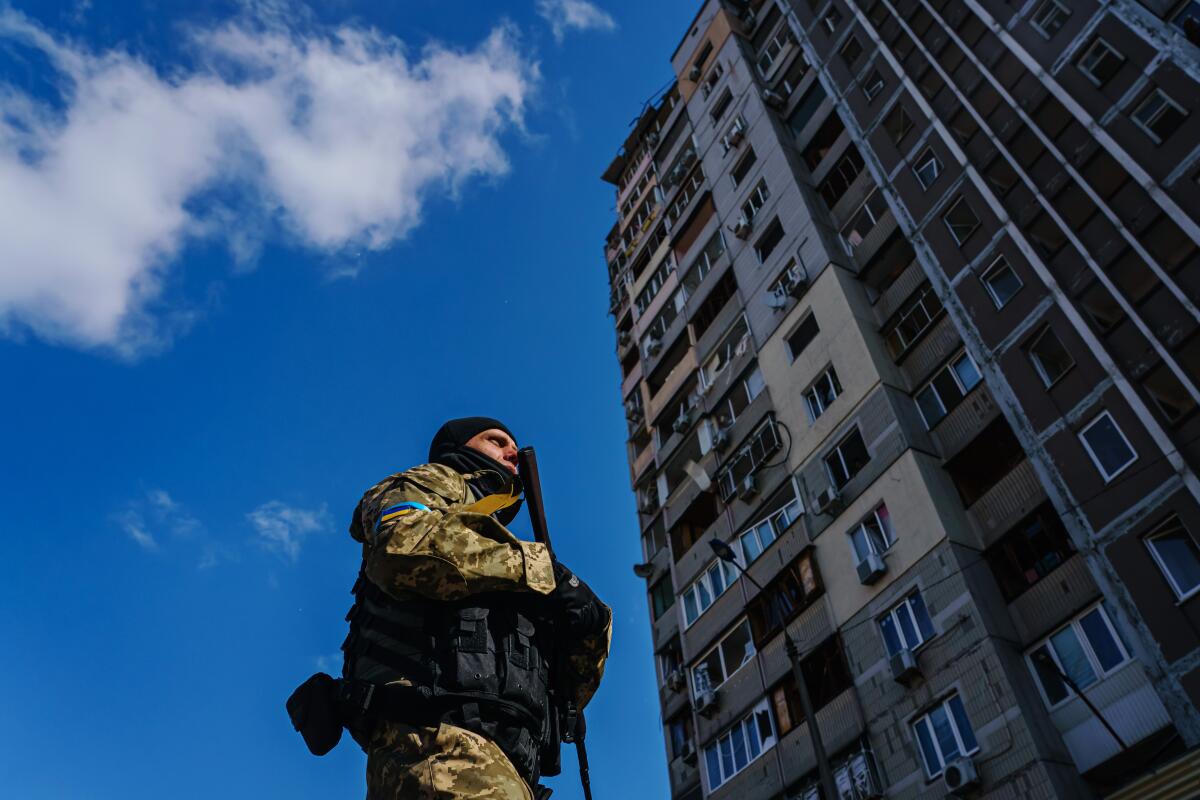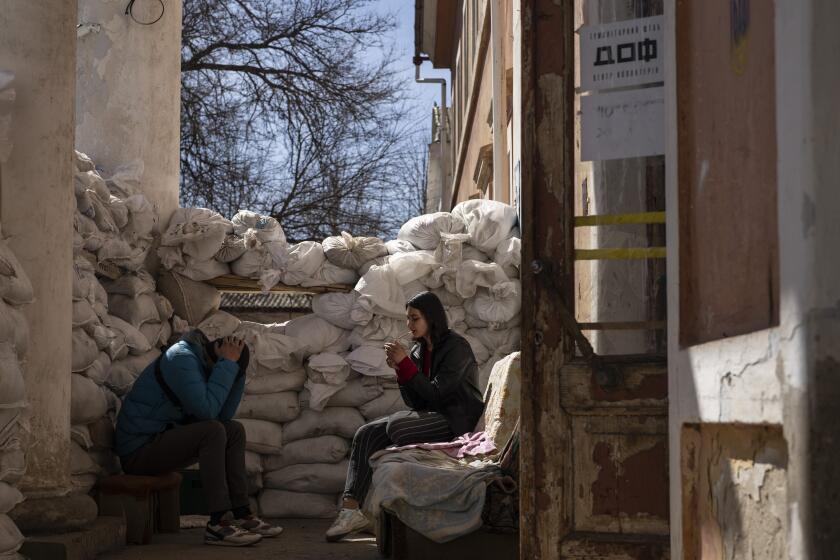How does the war in Ukraine end?

- Share via
Vladimir Putin is in a predicament. In the first 20 days of fighting, by one conservative Pentagon estimate, more than 7,000 Russian troops were killed — greater than 20 years of U.S. losses in Afghanistan and Iraq. NATO’s figures are even higher — up to 40,000 Russians killed, wounded, missing or taken prisoner. Retired Army Gen. David H. Petraeus assessed it simply: The Russians, and Ukrainians, are stuck in “a bloody stalemate.”
“Tell me how this ends” was a Petraeus catchphrase when he served as a major general early in the Iraq war. Applied to the war in Ukraine, answers are starting to appear.
The West’s economic attacks aren’t going to halt the fighting. The world’s condemnation of Putin has been unified, swift and ever-increasing, but sanctions can do little to hasten the outcome in the short term. We in the West place too much faith in frozen bank accounts and the ruble tanking. We are mirror-imaging, imagining that if we faced the same hardships as the Russians, we’d demand our government retreat right away. But we aren’t Russian. At best, sanctions are one factor, not the thing that pushes the parties to serious talks.
Battlefield success isn’t doing it either. Neither side can militarily defeat their opponent.
Moscow says it will scale back its offensive around the Ukrainian cities of Kyiv and Chernihiv in part to give more impetus to peace talks.
The Russians don’t have the capacity for an outright victory in conventional warfare. Experts from the beginning have noted that Russia lacks the troops on the ground to seize cities and hold terrain. No amount of scorched-earth threats — chemical, biological or tactical nuclear weapons — will change the fact that Russia cannot control Ukraine without calling up conscripts, which would further devastate its economy.
As for the much-smaller Ukrainian forces, even with infusions of materiel from the West and their remarkable resilience thus far, they also would not win a war of attrition, even if it went on for years.
But hope lies in facts on the ground. Call it diplomacy forced by force.
War is many awful things, but it at least reveals raw truths to the combatants. Whatever wishful falsehoods the parties told themselves about their strengths and their adversary’s weaknesses pre-contact, fighting dispels them. It is objective. It focuses the public mind; it makes it so that political leaders cannot avoid hard calls they otherwise might ignore.
In 2009, the U.S. Army commissioned more than a dozen top historians to review how America ends its wars. The study covered conflicts as far back as the Revolutionary War, right up to the moment the question was posed. It identified important patterns, summarized in an essay by military historian Roger Spiller.
“Wars are defined,” wrote Spiller, “not by their extremes but by their limitations.” “No matter how unyielding or uncompromising” a war’s initial aims may be, they “are constantly revised by the stresses and actions of war.” And all sides “gradually converge toward an agreement to stop fighting.”
That may be what we’re seeing now — a willingness to concede previously untouchable topics in light of newly realized pain and failure.
Diplomats from the two sides met in Turkey on Tuesday. Russia said it was ready to set a meeting between Putin and Zelensky when a draft peace agreement is ready. A deputy Russian defense minister claimed Russia would “reduce military activity” near Kyiv, a significant shift from a month ago, when the rough rhetoric of regime change and the subjugation of all Ukraine headed the Kremlin’s talking points.
Zelensky has already signaled flexibility on Ukraine’s goal of joining NATO and suggested a framework for “discussions” on Crimea and the Donbas.
Handicapping outcomes at this early stage amounts to strategic malpractice, but we know how the road to peace must be built.
It begins with Putin accepting that what he reached for is more than his army can hold. The bargaining will not look kind or generous on Russia’s part, but Putin will have to concede enough to convince Zelensky to call off the rhetorical, financial and diplomatic dogs.
Then attention shifts to Zelensky. Only he can bring the world back to Russia. That’s his leverage in the negotiations. Putin may have more rockets and RPGs, but Zelensky’s golden voice currently commands the globe.
It is Zelensky’s say-so that will unwind what Putin calls the West’s “economic blitzkrieg.” Zelensky alone can coax back the hundreds of global companies that have fled Russia (and Ukraine). These companies left because of an illegal war, and they will only return for a just peace, which requires more than just the two parties at the signing ceremony.
The last hurdle will be convincing the Ukrainian people to accept a bargain. Whatever specific deal emerges, it will contain shattering concessions. Every inch of Ukrainian ground given up will seem like sacred soil. The terms will feel like surrender, and it will be a Herculean task for the millions whose lives have been destroyed by Russia’s hubris to agree that any compromise could possibly be worth what’s been sacrificed.
That may be the toughest challenge Zelensky has yet faced. Because war is hard, peace is hard.
Lt. Col. ML Cavanaugh is an Army strategist and a senior fellow with the Modern War Institute. These are the author’s views, not those of the U.S. government. @MLCavanaugh
More to Read
A cure for the common opinion
Get thought-provoking perspectives with our weekly newsletter.
You may occasionally receive promotional content from the Los Angeles Times.










